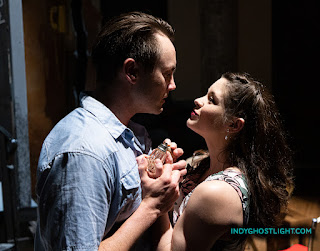Dami Kim returns to town to conclude the IVCI's Laureate Series
The Laureate Series provides a valuable guide for confirming (or otherwise) the jury's decisions over the course of nine International Violin Competition of Indianapolis contests. IVCI patrons get to hear representatives from among the top six participants chosen every four years since 1982.
Does the pressure-cooker environment make or mar a developing concert violinist? Do jury choices, despite safeguards against logrolling and unbalanced influence, stand up over time as a fair indicator of who deserves long-term stature on the concert stage? These are questions without definitive answers, though every laureate's return here suggests possibilities.
The 2017-18 series concluded Tuesday night at the Indiana History Center with a recital by fourth-place laureate Dami Kim from the most recent competition (2014). She received able assistance at the piano from Chih-Yi Chen, who teaches collaborative piano at Indiana University's Jacobs School of Music.
The virtuoso flourishes that pack "The Red Violin Caprices," the program's one unaccompanied work, were impressively dispatched, despite some blur and glare up high at first. The climax of John Corigliano's concert setting of music he wrote for the film "The Red Violin" (1998, an Oscar-winning score) raised the excitement to fever pitch. Such music didn't represent the height of her artistry, though its place on the program was deserved.
Her strengths lie more in the area of romantic expressiveness, asserted by how apt her playing sounded in the opening work, Schumann's Three Fantasy Pieces, op. 73. With rolling figures coming smoothly from the keyboard, the violinist displayed her delicately regulated response to the opening piece. She characterized the contrast between the first and second pieces brightly, lightening the tonal palette. The concluding piece, ratcheting up the set's expressive profile, had the "fire" stipulated by its heading. The open-hearted commitment of both players stirred the soul.
Schumann was also represented after the Corigliano, by his late Sonata No. 1 in A minor, op. 105. The performance consistently displayed the duo's rapport, with well-coordinated changes in tempo and dynamics when called for. The tension and mystery of the first movement's final measures set up superbly the melting lyricism of the second movement. I was struck by Kim's evident ability to phrase like a singer. Her tone was sweet but not sugary — an advantage as well in her encore, the Meditation from Massenet's "Thais," which can easily sound treacly.
I was reminded Tuesday by what I noticed about her manner in a Mozart sonata she played in competition almost four years ago: "When understatement was called for, her tone kept its spine," I wrote at the time. For reflective, inward-looking music to also maintain a sturdy core is an outstanding characteristic of Kim's playing. The finale, marked Lebhaft (lively), had a pixieish zest that suggested Black Forest folklore.
The violinist's ability to enunciate broad, arching phrases without overloading them in the slow movement of Beethoven's Sonata No. 6 in A major also suggested she may be inspired by singers. As for the rest of that work, the opening Allegro had a gracious quality throughout, contributed by both players, yet without ignoring the composer's love of "sforzando" punctuation. As for the finale, I would have liked something more sprightly in the first variation, which flowed without quite enough contrast to the theme. Other variations were more discretely characterized, and the climax had the right infectious pep.
The recital concluded with a flamboyant, slightly obsessive Concert Fantasy on Themes from Gershwin's "Porgy and Bess," by Igor Frolov, a composer-violinist born in and largely shaped by the Soviet Union. It's no wonder that an artist reared by Stalinism might have great affection for "It Ain't Necessarily So." That declaration of skepticism by Sportin' Life is treated to extensive treatment in this piece. Porgy's love song, "Bess, You Is My Woman Now," is used to impose cohesiveness on Frolov's tribute: The pianist quotes it in an introduction before it becomes both an ardent vehicle for the violin and returns yet again in a broadened climax.
Chen's chops were conspicuously brought into play in a couple of places. The bustle of the overture and the raucous chorus that begins, "I ain't got no shame, doin' what I like to do" helped to balance the plethora of melody. And the tunes were a treat to hear the way Kim played them, as her lyrical gift dependably came through. "My Man's Gone Now" and "Summertime" were the major illustrations, with passages in harmonics just where you'd expect them to be. (It's a peculiar feature of the opera that Bess never gets the best women's music, including those songs just mentioned; her "I Loves You, Porgy" is of a lower order than "Bess, You Is My Woman Now," and Frolov understandably ignores it. But dramatically, the role almost overshadows Porgy, and black sopranos tend to love it.)
Despite its odd disproportions, Kim's choice of this piece to end the printed program is to be applauded. In the mid- to late-20th century, recitals by violinists, pianists, and singers trended toward earnestness from first to last. Way before that, recitalists always moved toward lighter, more colorful music toward program's end. This is the kind of balance that is worth being restored, especially when it is done with the sort of conviction and finesse Kim and Chen brought to it.
 |
| Dami Kim and Chih-Yi Chen concluded the Laureate Series season |
Does the pressure-cooker environment make or mar a developing concert violinist? Do jury choices, despite safeguards against logrolling and unbalanced influence, stand up over time as a fair indicator of who deserves long-term stature on the concert stage? These are questions without definitive answers, though every laureate's return here suggests possibilities.
The 2017-18 series concluded Tuesday night at the Indiana History Center with a recital by fourth-place laureate Dami Kim from the most recent competition (2014). She received able assistance at the piano from Chih-Yi Chen, who teaches collaborative piano at Indiana University's Jacobs School of Music.
The virtuoso flourishes that pack "The Red Violin Caprices," the program's one unaccompanied work, were impressively dispatched, despite some blur and glare up high at first. The climax of John Corigliano's concert setting of music he wrote for the film "The Red Violin" (1998, an Oscar-winning score) raised the excitement to fever pitch. Such music didn't represent the height of her artistry, though its place on the program was deserved.
Her strengths lie more in the area of romantic expressiveness, asserted by how apt her playing sounded in the opening work, Schumann's Three Fantasy Pieces, op. 73. With rolling figures coming smoothly from the keyboard, the violinist displayed her delicately regulated response to the opening piece. She characterized the contrast between the first and second pieces brightly, lightening the tonal palette. The concluding piece, ratcheting up the set's expressive profile, had the "fire" stipulated by its heading. The open-hearted commitment of both players stirred the soul.
Schumann was also represented after the Corigliano, by his late Sonata No. 1 in A minor, op. 105. The performance consistently displayed the duo's rapport, with well-coordinated changes in tempo and dynamics when called for. The tension and mystery of the first movement's final measures set up superbly the melting lyricism of the second movement. I was struck by Kim's evident ability to phrase like a singer. Her tone was sweet but not sugary — an advantage as well in her encore, the Meditation from Massenet's "Thais," which can easily sound treacly.
I was reminded Tuesday by what I noticed about her manner in a Mozart sonata she played in competition almost four years ago: "When understatement was called for, her tone kept its spine," I wrote at the time. For reflective, inward-looking music to also maintain a sturdy core is an outstanding characteristic of Kim's playing. The finale, marked Lebhaft (lively), had a pixieish zest that suggested Black Forest folklore.
The violinist's ability to enunciate broad, arching phrases without overloading them in the slow movement of Beethoven's Sonata No. 6 in A major also suggested she may be inspired by singers. As for the rest of that work, the opening Allegro had a gracious quality throughout, contributed by both players, yet without ignoring the composer's love of "sforzando" punctuation. As for the finale, I would have liked something more sprightly in the first variation, which flowed without quite enough contrast to the theme. Other variations were more discretely characterized, and the climax had the right infectious pep.
The recital concluded with a flamboyant, slightly obsessive Concert Fantasy on Themes from Gershwin's "Porgy and Bess," by Igor Frolov, a composer-violinist born in and largely shaped by the Soviet Union. It's no wonder that an artist reared by Stalinism might have great affection for "It Ain't Necessarily So." That declaration of skepticism by Sportin' Life is treated to extensive treatment in this piece. Porgy's love song, "Bess, You Is My Woman Now," is used to impose cohesiveness on Frolov's tribute: The pianist quotes it in an introduction before it becomes both an ardent vehicle for the violin and returns yet again in a broadened climax.
Chen's chops were conspicuously brought into play in a couple of places. The bustle of the overture and the raucous chorus that begins, "I ain't got no shame, doin' what I like to do" helped to balance the plethora of melody. And the tunes were a treat to hear the way Kim played them, as her lyrical gift dependably came through. "My Man's Gone Now" and "Summertime" were the major illustrations, with passages in harmonics just where you'd expect them to be. (It's a peculiar feature of the opera that Bess never gets the best women's music, including those songs just mentioned; her "I Loves You, Porgy" is of a lower order than "Bess, You Is My Woman Now," and Frolov understandably ignores it. But dramatically, the role almost overshadows Porgy, and black sopranos tend to love it.)
Despite its odd disproportions, Kim's choice of this piece to end the printed program is to be applauded. In the mid- to late-20th century, recitals by violinists, pianists, and singers trended toward earnestness from first to last. Way before that, recitalists always moved toward lighter, more colorful music toward program's end. This is the kind of balance that is worth being restored, especially when it is done with the sort of conviction and finesse Kim and Chen brought to it.



Comments
Post a Comment